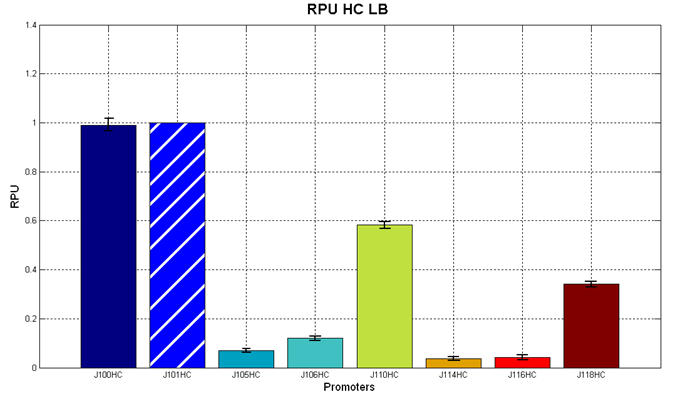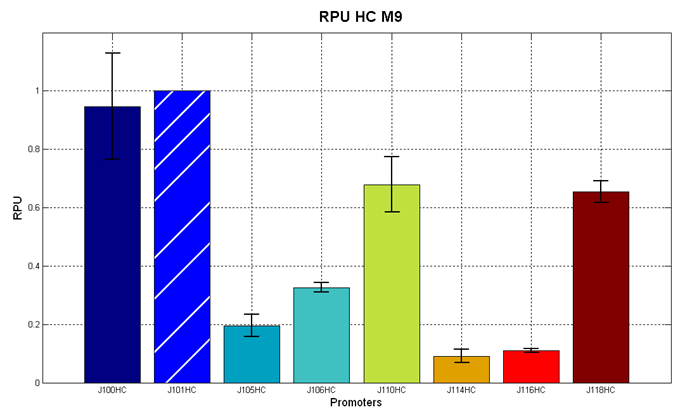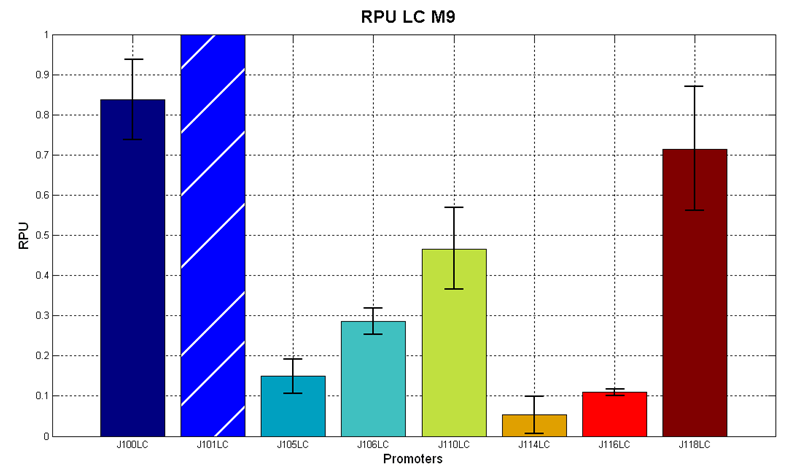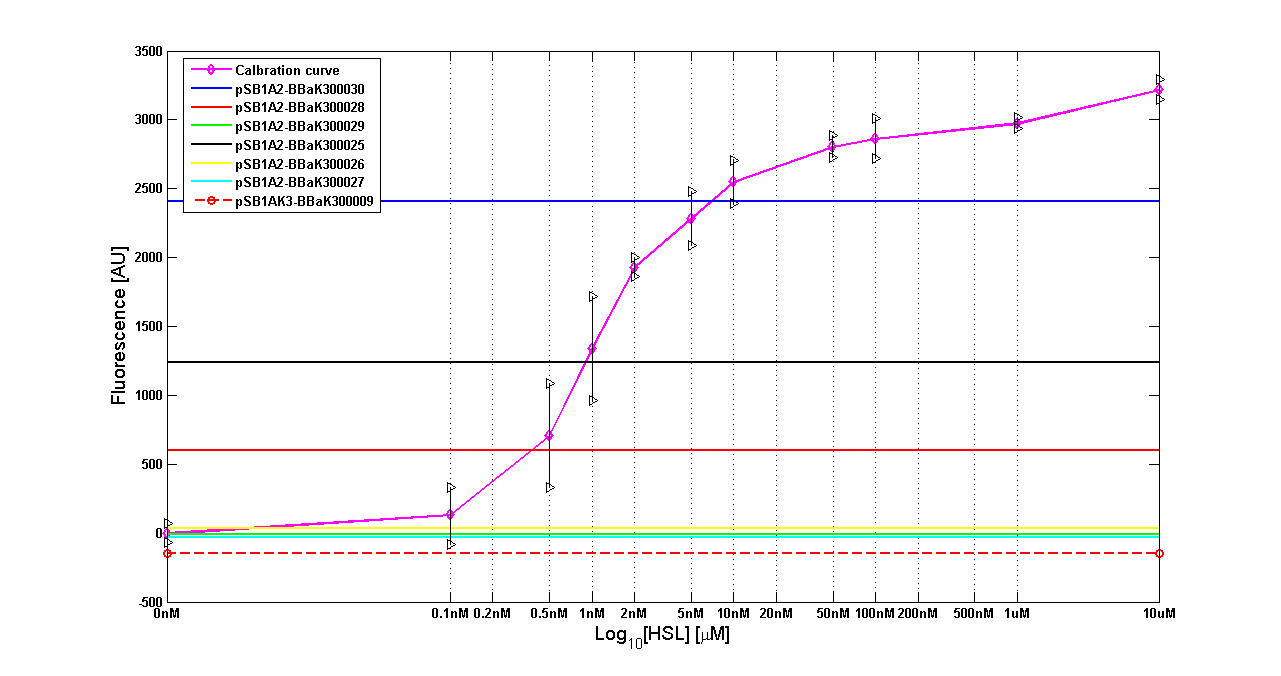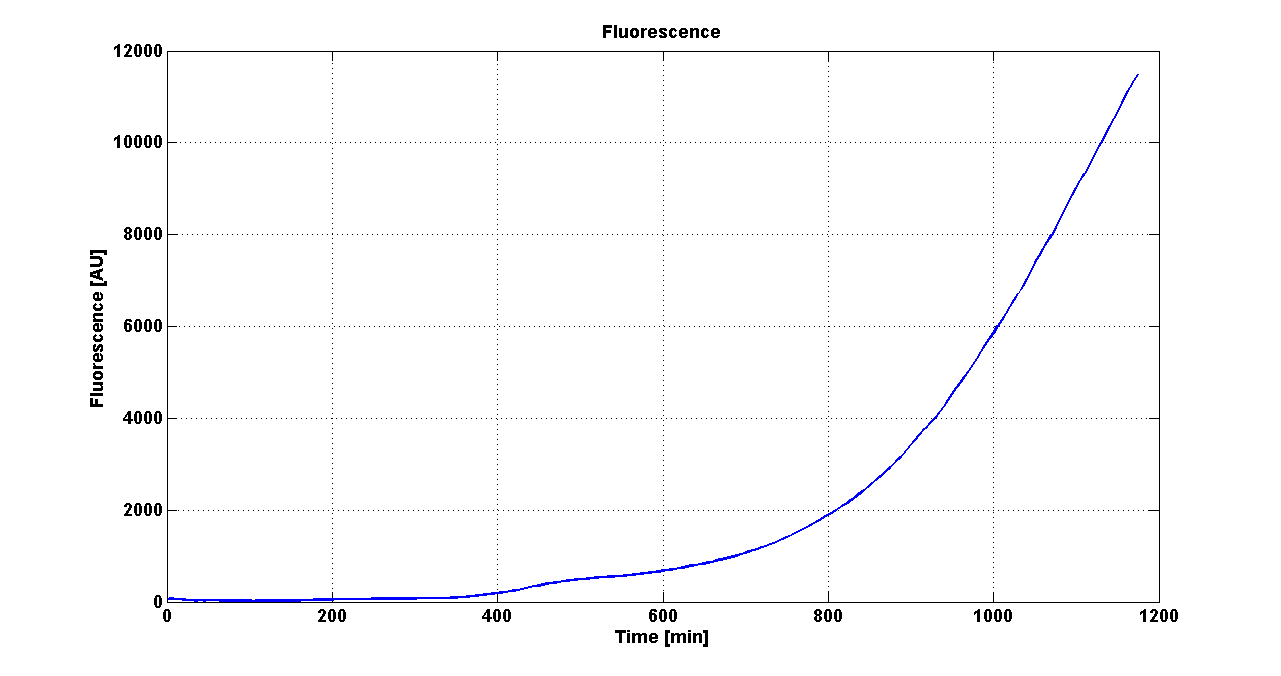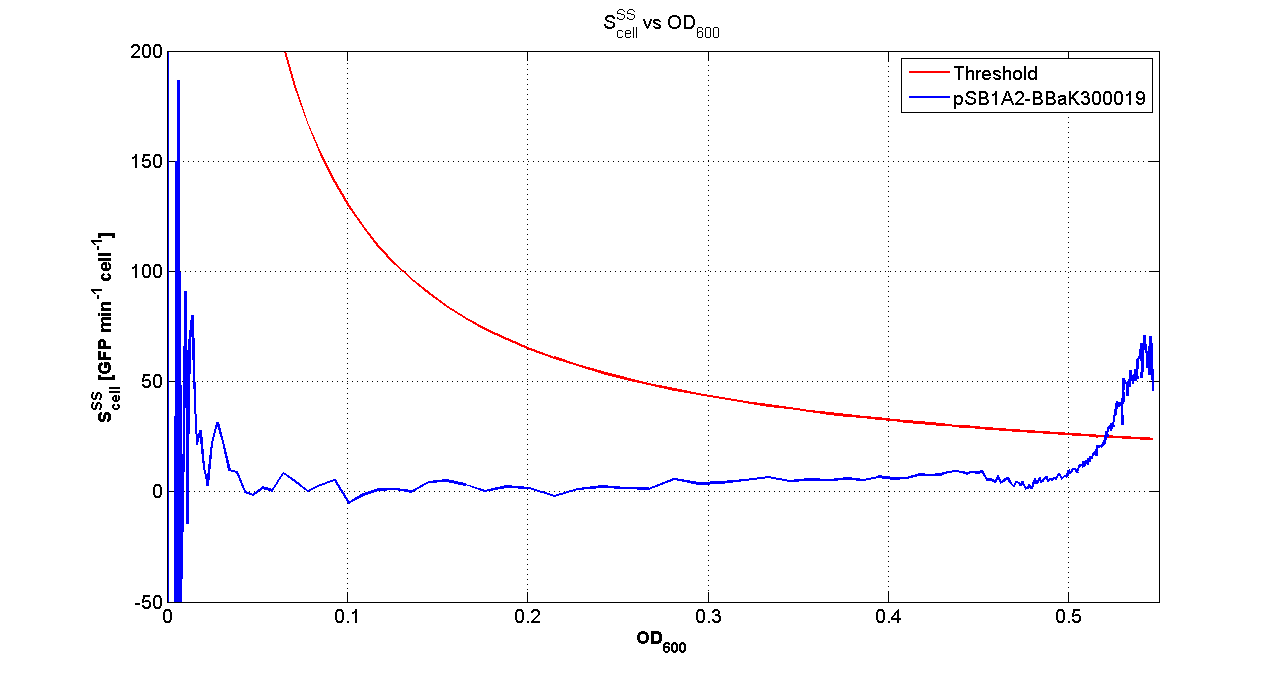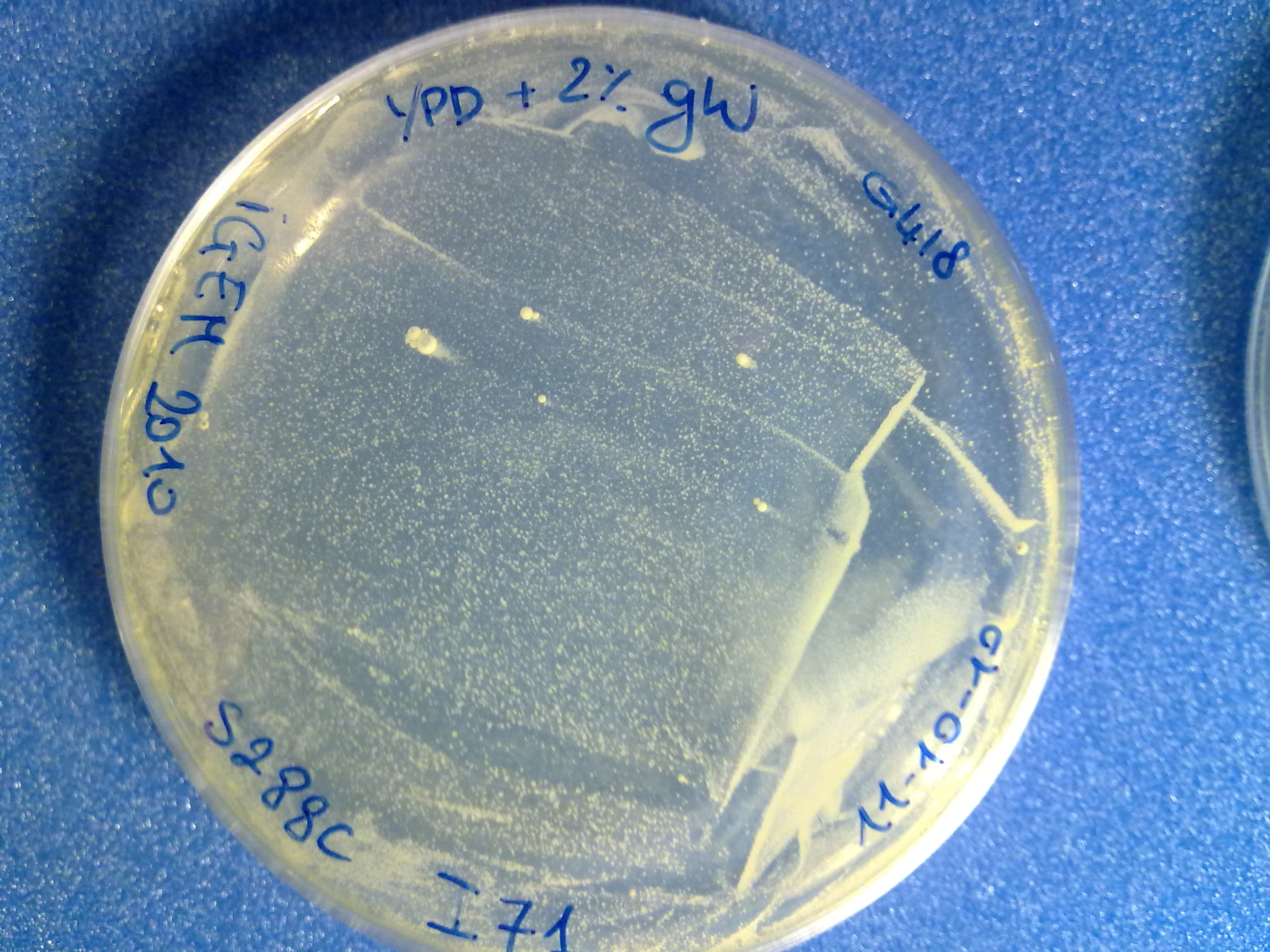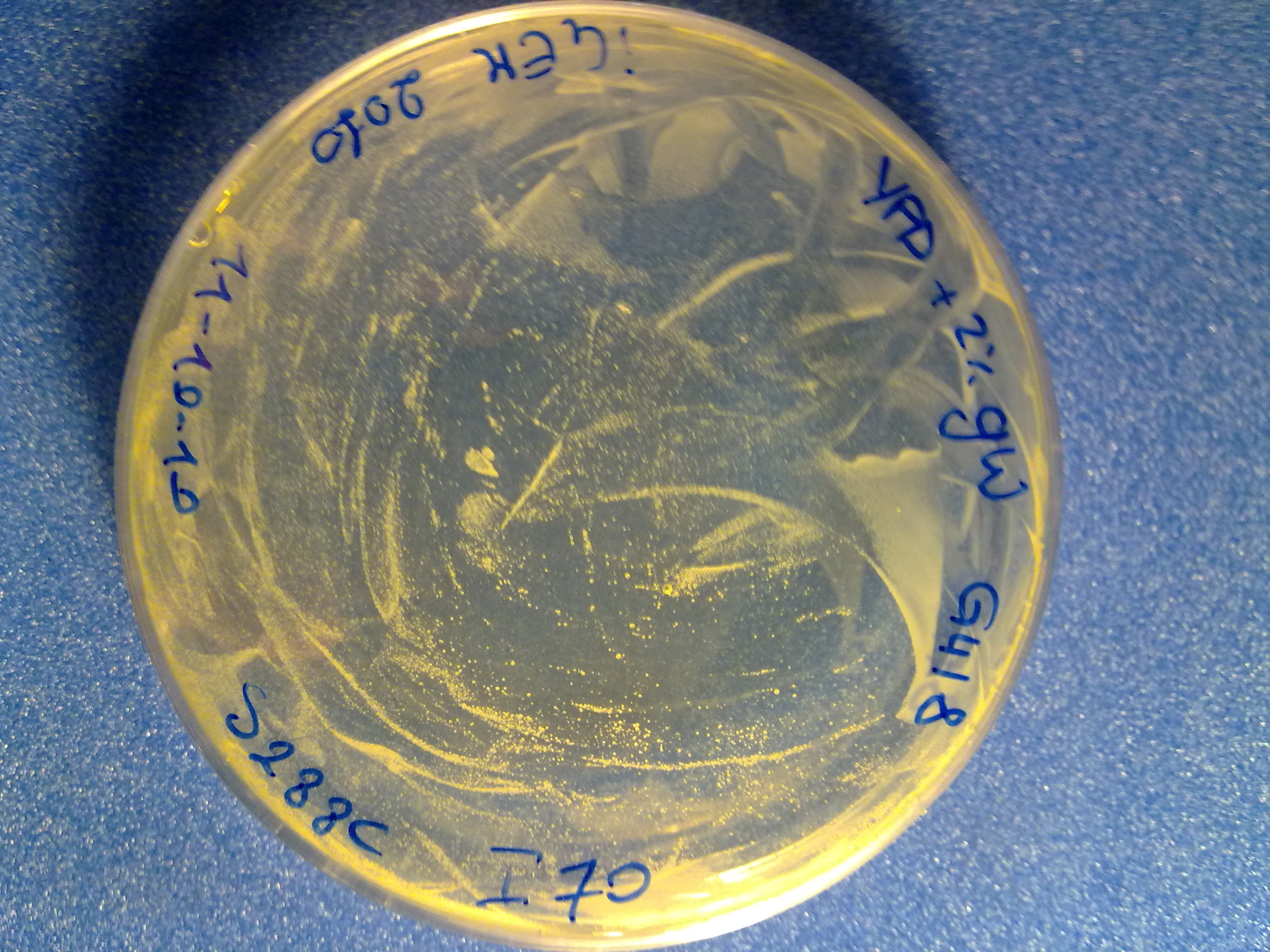Team:UNIPV-Pavia/Project/results
From 2010.igem.org
(→TOGLIMI) |
(→TOGLIMI) |
||
| Line 370: | Line 370: | ||
|Sender and Receiver are contained<br> in two different plasmids, <br>cotransformed in the same cell | |Sender and Receiver are contained<br> in two different plasmids, <br>cotransformed in the same cell | ||
|} | |} | ||
| - | |||
| - | |||
Cultures of ''E. coli'' TOP10 bearing the plasmids containing the self-inducible devices expressing G.F.P. were grown according to [[Team:UNIPV-Pavia/Parts/Characterization#Microplate reader experiments for self-inducible promoters - Protocol #1|this protocol]] and all data collected were analyzed as explained in [[Team:UNIPV-Pavia/Parts/Characterization#Data analysis for self-inducible promoters (initiation-treshold determination)|this section]] | Cultures of ''E. coli'' TOP10 bearing the plasmids containing the self-inducible devices expressing G.F.P. were grown according to [[Team:UNIPV-Pavia/Parts/Characterization#Microplate reader experiments for self-inducible promoters - Protocol #1|this protocol]] and all data collected were analyzed as explained in [[Team:UNIPV-Pavia/Parts/Characterization#Data analysis for self-inducible promoters (initiation-treshold determination)|this section]] | ||
| Line 387: | Line 385: | ||
For every self-inducible device, several parameters were evaluated, as reported [[Team:UNIPV-Pavia/Parts/Characterization#Data analysis for self-inducible promoters (initiation-treshold determination)| in this section]]. Results are summarized in the following tables: | For every self-inducible device, several parameters were evaluated, as reported [[Team:UNIPV-Pavia/Parts/Characterization#Data analysis for self-inducible promoters (initiation-treshold determination)| in this section]]. Results are summarized in the following tables: | ||
| + | |||
| + | ====TOGLIMI==== | ||
| + | |||
'''Tab. 1 - Sender and Receiver on high copy plasmid <partinfo>pSB1A2</partinfo>''' | '''Tab. 1 - Sender and Receiver on high copy plasmid <partinfo>pSB1A2</partinfo>''' | ||
| Line 403: | Line 404: | ||
|- | |- | ||
|<partinfo>BBa_K300014</partinfo> (wiki name: I8) in <partinfo>pSB1A2</partinfo> plasmid | |<partinfo>BBa_K300014</partinfo> (wiki name: I8) in <partinfo>pSB1A2</partinfo> plasmid | ||
| - | |[[Image:pv_BBa_K300014.png|400px]] | + | |[[Image:pv_BBa_K300014.png|400px]] |
| | | | ||
| | | | ||
| Line 412: | Line 413: | ||
|- | |- | ||
|<partinfo>BBa_K300015</partinfo> (wiki name: I9) in <partinfo>pSB1A2</partinfo> plasmid | |<partinfo>BBa_K300015</partinfo> (wiki name: I9) in <partinfo>pSB1A2</partinfo> plasmid | ||
| - | |[[Image:pv_BBa_K300015.png|400px]] | + | |[[Image:pv_BBa_K300015.png|400px]] |
| | | | ||
| | | | ||
| Line 421: | Line 422: | ||
|- | |- | ||
|<partinfo>BBa_K300016</partinfo> (wiki name: I10) in <partinfo>pSB1A2</partinfo> plasmid | |<partinfo>BBa_K300016</partinfo> (wiki name: I10) in <partinfo>pSB1A2</partinfo> plasmid | ||
| - | |[[Image:pv_BBa_K300016.png|400px]] | + | |[[Image:pv_BBa_K300016.png|400px]] |
| | | | ||
| | | | ||
| Line 430: | Line 431: | ||
|- | |- | ||
|<partinfo>BBa_K300012</partinfo> (wiki name: I12) in <partinfo>pSB1A2</partinfo> plasmid | |<partinfo>BBa_K300012</partinfo> (wiki name: I12) in <partinfo>pSB1A2</partinfo> plasmid | ||
| - | |[[Image:pv_BBa_K300012.png|400px]] | + | |[[Image:pv_BBa_K300012.png|400px]] |
| | | | ||
| | | | ||
| Line 453: | Line 454: | ||
|- | |- | ||
|<del><partinfo>BBa_K300014</partinfo> (wiki name: I8) in <partinfo>pSB1A2</partinfo> plasmid</del> | |<del><partinfo>BBa_K300014</partinfo> (wiki name: I8) in <partinfo>pSB1A2</partinfo> plasmid</del> | ||
| - | |[[Image:pv_BBa_K300014.png|400px]] | + | |[[Image:pv_BBa_K300014.png|400px]] |
| Not detectable | | Not detectable | ||
| Not detectable | | Not detectable | ||
| Line 462: | Line 463: | ||
|- | |- | ||
|<del><partinfo>BBa_K300015</partinfo> (wiki name: I9) in <partinfo>pSB1A2</partinfo> plasmid</del> | |<del><partinfo>BBa_K300015</partinfo> (wiki name: I9) in <partinfo>pSB1A2</partinfo> plasmid</del> | ||
| - | |[[Image:pv_BBa_K300015.png|400px]] | + | |[[Image:pv_BBa_K300015.png|400px]] |
| Not detectable | | Not detectable | ||
| Not detectable | | Not detectable | ||
| Line 471: | Line 472: | ||
|- | |- | ||
|<del><partinfo>BBa_K300016</partinfo> (wiki name: I10) in <partinfo>pSB1A2</partinfo> plasmid</del> | |<del><partinfo>BBa_K300016</partinfo> (wiki name: I10) in <partinfo>pSB1A2</partinfo> plasmid</del> | ||
| - | |[[Image:pv_BBa_K300016.png|400px]] | + | |[[Image:pv_BBa_K300016.png|400px]] |
| Not detectable | | Not detectable | ||
| Not detectable | | Not detectable | ||
| Line 480: | Line 481: | ||
|- | |- | ||
|<del><partinfo>BBa_K300012</partinfo> (wiki name: I12) in <partinfo>pSB1A2</partinfo> plasmid</del> | |<del><partinfo>BBa_K300012</partinfo> (wiki name: I12) in <partinfo>pSB1A2</partinfo> plasmid</del> | ||
| - | |[[Image:pv_BBa_K300012.png|400px]] | + | |[[Image:pv_BBa_K300012.png|400px]] |
| Not detectable | | Not detectable | ||
| Not detectable | | Not detectable | ||
| Line 494: | Line 495: | ||
|'''Self-inducible device''' || '''Description''' || '''O.D.start LB''' || '''K_HSL LB'''|| '''Doubling time LB'''|| '''O.D.start M9''' || '''K_HSL M9'''|| '''Doubling time M9''' | |'''Self-inducible device''' || '''Description''' || '''O.D.start LB''' || '''K_HSL LB'''|| '''Doubling time LB'''|| '''O.D.start M9''' || '''K_HSL M9'''|| '''Doubling time M9''' | ||
|- | |- | ||
| - | |<partinfo>BBa_K300030</partinfo> (wiki name: I14) in <partinfo>pSB4C5</partinfo> plasmid | + | |<partinfo>BBa_K300030</partinfo><br> (wiki name: I14) <br>in <partinfo>pSB4C5</partinfo> plasmid |
| - | |[[Image:pv_BBa_K300030.png| | + | |[[Image:pv_BBa_K300030.png|150px]]+[[Image:pv_BBa_F2620.png|150px]]<br> LC               HC |
| | | | ||
| | | | ||
| Line 503: | Line 504: | ||
| | | | ||
|- | |- | ||
| - | |<partinfo>BBa_K300028</partinfo> (wiki name: I15) in <partinfo>pSB4C5</partinfo> plasmid | + | |<partinfo>BBa_K300028</partinfo><br> (wiki name: I15)<br> in <partinfo>pSB4C5</partinfo> plasmid |
| - | |[[Image:pv_BBa_K300028.png| | + | |[[Image:pv_BBa_K300028.png|150px]]+[[Image:pv_BBa_F2620.png|150px]]<br> LC HC |
| | | | ||
| | | | ||
| Line 512: | Line 513: | ||
| | | | ||
|- | |- | ||
| - | |<partinfo>BBa_K300029</partinfo> (wiki name: I16) in <partinfo>pSB4C5</partinfo> plasmid | + | |<partinfo>BBa_K300029</partinfo><br> (wiki name: I16)<br> in <partinfo>pSB4C5</partinfo> plasmid |
| - | |[[Image:pv_BBa_K300029.png| | + | |[[Image:pv_BBa_K300029.png|150px]]+[[Image:pv_BBa_F2620.png|150px]]<br> LC HC |
| | | | ||
| | | | ||
| Line 521: | Line 522: | ||
| | | | ||
|- | |- | ||
| - | |<partinfo>BBa_K300025</partinfo> (wiki name: I17) in <partinfo>pSB4C5</partinfo> plasmid | + | |<partinfo>BBa_K300025</partinfo><br> (wiki name: I17) <br>in <partinfo>pSB4C5</partinfo> plasmid |
| - | |[[Image:pv_BBa_K300025.png| | + | |[[Image:pv_BBa_K300025.png|150px]]+[[Image:pv_BBa_F2620.png|150px]]<br> LC HC |
| | | | ||
| | | | ||
| Line 530: | Line 531: | ||
| | | | ||
|- | |- | ||
| - | |<partinfo>BBa_K300026</partinfo> (wiki name: I18) in <partinfo>pSB4C5</partinfo> plasmid | + | |<partinfo>BBa_K300026</partinfo><br> (wiki name: I18) <br>in <partinfo>pSB4C5</partinfo> plasmid |
| - | |[[Image:pv_BBa_K300026.png| | + | |[[Image:pv_BBa_K300026.png|150px]]+[[Image:pv_BBa_F2620.png|150px]]<br> LC HC |
| | | | ||
| | | | ||
| Line 539: | Line 540: | ||
| | | | ||
|- | |- | ||
| - | |<partinfo>BBa_K300027</partinfo> (wiki name: I19) in <partinfo>pSB4C5</partinfo> plasmid | + | |<partinfo>BBa_K300027</partinfo><br> (wiki name: I19)<br> in <partinfo>pSB4C5</partinfo> plasmid |
| - | |[[Image:pv_BBa_K300027.png| | + | |[[Image:pv_BBa_K300027.png|150px]]+[[Image:pv_BBa_F2620.png|150px]]<br> LC HC |
| | | | ||
| | | | ||
| Line 552: | Line 553: | ||
{| | {| | ||
|[[Image:pv_SwitchPointLB.png|400px|thumb|center| Average growth curve with ODstart evaluated by Threshold algorithm in LB]] | |[[Image:pv_SwitchPointLB.png|400px|thumb|center| Average growth curve with ODstart evaluated by Threshold algorithm in LB]] | ||
| - | |[[Image:pv_SwitchPointM9.png|400px|thumb|center| Average growth curve with ODstart evaluated by Threshold algorithm in M9]] | + | |[[Image:pv_SwitchPointM9.png|400px|thumb|center| Average growth curve with ODstart evaluated by Threshold algorithm in M9]] |
|} | |} | ||
Revision as of 13:35, 24 October 2010
|
Self-inducible promotersRegulation of signal protein productuionExperimental implementation: <partinfo>BBa_K300009</partinfo> part was assembled downstream of different constitutive promoters, thus obtaining a signal molecule generator. The choice of constitutive promoters was performed between the ones belonging to the [http://partsregistry.org/Part:BBa_J23101 Anderson’s promoters collection] ; we chose promoters according to their activities reported in the Registry of Standard Biological Parts, in order to have a thick mesh:
Before constructing the signal generators, <partinfo>BBa_K300009</partinfo> under the regulation of one of these constitutive promoters, we evaluated their activities in Relative Promoter Units (R.P.U.) according to Data analysis for RPU evaluation, using the reporter protein R.F.P. in different experimental conditions (plasmids’ copy number and growth medium) :
It was not possible to evaluate promoters activities in low copy number plasmids and LB because the RFP activity was too weak and not detectable and discernible from the background. Red Fluorescent Protein (RFP) fluorescence and Optical Density at 600nm (O.D.600) were measured by Tecan Infinite F200 as reported in Microplate reader experiments for constitutive promoters (R.P.U. evaluation) - Protocol #2 and data were analyzed as reported in DATA Analysis RPU; Results: results are shown here. Discussion: we observed that the Registry ranking is not always respected. As an example, <partinfo>BBa_J23110</partinfo> in high copy plasmid is stronger than <partinfo>BBa_J23118</partinfo>, in contrast with the ranking of the Registry. After the evaluation of promoters’ activity, signal generators were constructed in high copy and low copy plasmids: <partinfo>BBa_K300009</partinfo> and <partinfo>BBa_K300010</partinfo> were assembled downstream the above mentioned promoters, thus obtaining the following parts:
Quantification of the HSL producedExperimental implementation The new parts were, thus, characterized, measuring the HSL concentration released in the medium after a 6 hour growth of the cultures. All the details are available in this section. <partinfo>BBa_T9002</partinfo> sensor was contained in <partinfo>pSB1A3</partinfo> in E. coli TOP10. Results The amount of 3OC6-HSL produced after 6 hours growth by E. coli DH5alpha bearing the parts contained in high copy plasmid <partinfo>pSB1A2</partinfo> is reported in Figure 8 and in the table:
The amount of 3OC6-HSL produced after 6 hours growth by the parts contained in low copy plasmid <partinfo>pSB4C5</partinfo> is reported in Figure 9 and in the table:
Discussion These experiments provided extremely useful informations about the capability of the signal generator to produce 3OC6-HSL signal molecule. Data are partially uncompleted because for weak promoters ore medium-strength promoters contained in low copy number plasmid the amount of 3OC6-HSL was not detectable using this system. This simple experiment shows that there's a strong correlation between the strength of promoter and the amount of signal molecule produced, even if the correspondence is not exact, probably due to the fact that very strong promoters (such as <partinfo>BBa_J23101</partinfo>) give to the cells a high metabolic burden, thus resulting in lower production yields. Modulation of plasmid copy numberSignal generator and sensor device were assembled in an unique part (such as <partinfo>BBa_K300017</partinfo>, <partinfo>BBa_K300014</partinfo>, <partinfo>BBa_K300015</partinfo>, <partinfo>BBa_K300016</partinfo> and <partinfo>BBa_K300012</partinfo>) beared on high copy number plasmid <partinfo>pSB1A2</partinfo> or low copy number plasmid <partinfo>pSb4C5</partinfo>. A third alternative was the assembly of signal generator on a low copy number plasmid (<partinfo>pSB4C5</partinfo>) and the receiver device on high number plasmid (<partinfo>pSB1A2</partinfo>). The circuits we obtained and tested are summarized here:
ResultsThe following measurement systems were realized assembling GFP downstream of each self-inducible device. The parts characterized are reported in this table: Cultures of E. coli TOP10 bearing the plasmids containing the self-inducible devices expressing G.F.P. were grown according to this protocol and all data collected were analyzed as explained in this section Doubling times were estimated as explained here Thus, these BioBrick parts can be used to express recombinant proteins without adding an inducer to trigger the transcription of their genes; in large-scale production of such proteins this strategy could be also cost saving. For every self-inducible device, several parameters were evaluated, as reported in this section. Results are summarized in the following tables: TOGLIMITab. 1 - Sender and Receiver on high copy plasmid <partinfo>pSB1A2</partinfo> Tab. 2 - Sender and Receiver on low copy plasmid <partinfo>pSB4C5</partinfo> Tab. 3 - Sender on low copy plasmid <partinfo>pSB4C5</partinfo> and Receiver on high copy plasmid <partinfo>pSB1A3</partinfo>
Integrative standard vector for E. coliMaterials and MethodsPlasmids and strains: the <partinfo>BBa_J72008</partinfo> helper plasmid was kindly given by Prof. JC Anderson (UC Berkeley). MC1061 (<partinfo>BBa_K300078</partinfo>) and MG1655 (<partinfo>BBa_V1000</partinfo>) E. coli strains and the pCP20 helper plasmid were purchased from the Coli Genetic Stock Center (Yale University). DH5alpha (<partinfo>BBa_V1001</partinfo>) strain was purchased from Invitrogen.
The relative position of the P1, P2, P3 and P4 primers is shown in the figure below: Competent cells preparation: all the E. coli strains were made competent following a slightly modified version of the protocol described in [Sambrook J et al., 1989]. Briefly, cells were grown to and OD600 of ~0.4-0.6, harvested (4000 rpm, 10 min, 4°C) and the supernatant discarded. Cells were resuspended in (30 ml for each 50 ml of initial culture) pre-chilled Mg-Ca buffer (80 mM MgCl2, 20 mM CaCl2), centrifuged as before and the supernatant discarded. Cells were resuspended in (2 ml for each 50 ml of initial culture) pre-chilled Ca buffer (100 mM CaCl2, 15% glycerol), aliquoted in 0.5 ml tubes and freezed immediately at -80°C. Test the transformation efficiency as:
efficiency [CFU/ug of DNA]= # CFU * 1000 ng of DNA / amount of transformed DNA [ng]
Self-ligated <partinfo>BBa_K300008</partinfo> was prepared by digesting <partinfo>pSB1A2</partinfo>-<partinfo>BBa_K300008</partinfo> (yielded by BioBrick Standard Assembly) with XbaI-SpeI. The insert was isolated and purified from a 1% agarose gel. Then, it was self-ligated to generate a Cm-resistant R6K plasmid. The colonies were counted in each plate and the transformation efficiency was estimated as described before. The Chloramphenicol concentration in plates was 34 ug/ml for the high copy plasmids, 12.5 ug/ml for the medium/low copy plasmids and 12.5 for the three control strains transformed with the R6K plasmid.
All the DNA manipulations were performed according to manufacturer's protocols.
Validate the loss of the helper plasmid by inoculating colonies in Cm (at 12.5 ug/ml) media and counterselecting them in Amp (at 50 ug/ml) media. Validate the correct integration position by performing colony PCR with primers P1/P2, P3/P4, P1/P4, P2,P3 and VF2/VR. Validate the phenotype (when possible).
Validate the loss of the helper plasmid by inoculating colonies in Amp (at 100 ug/ml) media and validate the loss of the Cm resistance from the genome by inoculating colonies in Cm (at 12.5 ug/ml) media. Validate the correct length of the integrated part without Cm resistance and R6K origin by performing colony PCR with primers P1/P4 (which amplify the entire Phi80 locus) and VF2/VR (which amplify the integrated part). Validate the phenotype (when possible).
ResultsValidation of pir strains to propagate the R6K replication originThe BW25141 (pir+) and BW23474 (pir-116) E. coli strains were chosen to propagate the vectors with the R6K replication origin at medium copy (~15 molecules per cell) and high copy (~250) respectively. The results about their capability to propagate R6K plasmids are shown here:
For this reason, competent cells were prepared again for MG1655 and the transformation procedure was repeated for this strain, yielding no colonies in the <partinfo>BBa_K300008</partinfo> plate as expected. Miniprep of the BW25141 and BW23474 strains transformed with <partinfo>BBa_K300008</partinfo> yielded a DNA concentration of ~20 ng/ul (qualitatively comparable with medium copy number plasmids) and ~90-100 ng/ul (qualitatively comparable with high copy number plasmids). The results shown in the table above also show that the R6K plasmid in pir+ and pir-116 strains was transformed with the same efficiency as the pSB*** positive control plasmid, demonstrating that the R6K origin doesn't give any handicap in plasmid transformation. So, the BW25141 and BW23474 strains can be successfully used to propagate the integrative vector after the excision of the pUC19-derived high copy replication origin, present in the default insert <partinfo>BBa_I52002</partinfo>. Integration of the desired BioBrick part into the Phi80 genome locusMC1061 and MG1655 were chosen as host strains for integration. <partinfo>BBa_K173001</partinfo> (constitutive strong promoter with GFPmut3) and the EcoRI-PstI fragment of <partinfo>BBa_J61002</partinfo>-<partinfo>BBa_J23101</partinfo> (here called PconRFP - constitutive strong promoter with RFP) were chosen as two proof of concept BioBrick parts to test the integration capability of the <partinfo>BBa_K300000</partinfo> vector in the Phi80 genome locus of these strains. For this reason, <partinfo>BBa_K173001</partinfo> and PconRFP were ligated in <partinfo>BBa_K300000</partinfo> (digested with EcoRI-PstI) and propagated using BW23474. The integration protocol was performed as described in the Materials and Methods section for 4 different combination:
Three colonies grown after the overnight incubation at 43°C (step 5 of integration protocol) were analyzed for each plate. These 12 clones were called: MC-GFP-A,B,C , MC-RFP-A,B,C , MG-GFP-A,B,C and MG-RFP-A,B,C.
Chloramphenicol resistance marker excisionAlthough MC-RFP and MG-RFP were actually multiple integrants, they were chosen as engineered strains for marker excision validation. The marker excision protocol was performed as described in the Materials and Methods section for both strains, here named:
DiscussionA novel integrative vector for E. coli has been successfully designed, constructed and used to integrate two proof of concept protein expression systems in two commonly used E. coli strains. The results showed that the vector is fully functional and can integrate into the correct targeted locus of the host chromosome through the Phi80 site-specific recombination system by using <partinfo>BBa_J72008</partinfo>, an existing BioBrick helper plasmid from the Registry. In most cases, the integration occurs in tandem copies, probably because of the too high Chloramphenicol concentration used during the selection of integrants, which forces multiple integration of Cm-resistant constructs. This concentration was the same used during the pSC101 low copy plasmid (~5 copies per cell) selection. In some cases, it is desirable to have a single copy of the desired BioBrick in the genome, for example when the gene dosage is important. In [Haldimann A and Wanner BL, 2001] the usage of Chloramphenicol at 6 ug/ml yielded a very high percentage of single integrants. However, when tested in our lab, the MG1655 strain could survive on LB plates with Cm at 6 ug/ml and also at 8 ug/ml. For this reason a higher concentration of Cm was chosen for selection. Further studies should investigate the optimal antibiotic concentration to yield the highest single integrants percentage as possible.
Integrative standard vector for yeastMaterials and MethodsStrain: the S. cerevisiae S288C strain (<partinfo>BBa_K300979</partinfo>, genotype: MATα ρ° trp1-0) was purchased from Open Biosystems. Construction of BBa_K300001:
[1] http://openwetware.org/wiki/High_Efficiency_Transformation [2] Guldener U, Heck S, Fiedler T, Beinhauer J, Hegemann JH (1996), A new efficient gene disruption cassette for repeated use in budding yeast. Nucleic Acids Research, Vol. 24, No. 13 2519–2524. ResultsThe transformed inserts and their integration efficiency in S288C are listed here:
The colony count was quite difficult (see pictures), but it is useful to have an estimation of the integration efficiency. DiscussionThe obtained results suggest that the integrative vector actually works and that the selection marker is highly specific (no colonies appeared on the "no DNA" plate). Although this integrative vector has already given promising integration results, a lot of work still remains to do:
As reported for the integrative vector for E. coli, the main information about the usage of this integrative vector for yeast is shared in the Registry. We hope to have positively contributed to the diffusion of standard biological parts for yeast, a very interesting chassis for synthetic biology for which only a limited number of parts are available in the Registry and only a few of them has been exaustively characterized.
Self-cleaving affinity tags to easily purify proteinsPHB productionFusion protein synthesisPhasins binding activity |
 "
"





